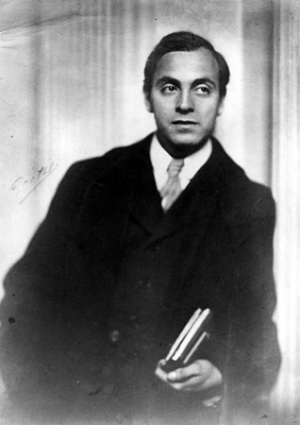Gallery
All Pictures (6)Biography
Ludwig Berger was born in Mainz on January 6, 1892, to banker Franz Bamberger and the pianist Anna Klara Bamberger (née Lewino). He received cello lessons at a young age. In 1910 he began to study art history and German studies in Munich and Heidelberg, and in 1914 he received his doctorate with a thesis on the painter Johann Conrad Seekatz. At the outbreak of World War I, Berger volunteered for military service, where he befriended the writer and playwright Carl Zuckmayer; however, due to periostitis, he was discharged from military service shortly thereafter as unfit.
Although he had never received any official training, Berger began to work as a director: He made his directorial debut in 1916 at the Stadttheater Mainz with a production of the Mozart opera "Gärtnerin aus Liebe"; the set design was created by his brother Rudolf Bamberger - the beginning of a regular collaboration. From 1917, Berger worked in Hamburg, Darmstadt and Berlin, where he made a name for himself primarily with Shakespeare productions. In addition, he published storybooks, poems and dramas.
Ludwig Berger made his debut as a film director in 1920 with the Calderon adaptation "Der Richter von Zalamea". For Decla-Bioscop, run by Erich Pommer, he made three more films with high-profile casts based on his own scripts until 1923: "Der Roman der Christine von Herre" (1921), "Ein Glas Wasser" ("One Glass of Water", 1923), in which Mady Christians was his leading lady for the first time, and the "Cinderella" adaptation "Der verlorene Schuh" ("The Lost Shoe", 1923), which prompted him to publish theoretical reflections on the relationship between fairy tales and film.
Until 1929, his brother Rudolf Bamberger was the art director on almost all of Berger's feature films, including the operetta adaptation "Ein Walzertraum" ("The Waltz Dream", 1925), whose great success earned the brothers an invitation to the USA. The last film the brothers made together was the romantic social drama "Das brennende Herz" ("The Burning Heart", 1929). Bamberger was also responsible for the sets and costumes in Berger's Berlin stage productions "Himmel und Hölle" (1920) and "Die Heilige aus USA" (1931). Berger's regular screenwriter since "Ein Walzertraum" was Robert Liebmann, who was involved in almost all of his German films until 1933.
The completion of "The Street of Sin" (US 1928), a film begun by Mauritz Stiller, was the start of Berger's work for Paramount in Hollywood. In 1928 he made two more silent films there and completed two sound films by 1930, including the color sound film "The Vagabond King", an operetta romanticizing the life of the French poet of the Late Middle Ages, François Villon.
In 1932 he made three language versions of the musical film "Ich bei Tag und Du bei Nacht" ("I by Day, You by Night") with Käthe von Nagy and Willy Fritsch for Ufa's Pommer production. With its ironic oscillation between dreary reality and shiny dream world the film is an example of Berger's typical approach. This was followed in 1933 - in two language versions - by "Der Walzerkrieg" ("Waltz War") with Renate Müller and Fritsch, until today one of his best-known films. Berger's way of staging, imbued with musicality and a delicate fairy-tale quality, was hailed by contemporaries as a "triumph of German filmmaking" (Willy Haas).
After the Nazis came to power in 1933, Berger, who was Jewish, wasn't allowed to work in Germany anymore. In 1935 he emigrated via France, first to the Netherlands, where he made the successful Shaw adaptation "Pygmalion" in 1936/37. Shortly thereafter he went to England and finally returned to Germany for a short time.
In 1938 he fled to Amsterdam with his mother. As a French production, he made "Les trois valses" ("Three Waltzes", 1938), for which he enlisted Oscar Straus as music composer. The British Alexander Korda production "The Thief of Bagdad", begun in 1938, became a personal fiasco for Berger due to considerable artistic differences with Korda: while Berger wanted to make a black-and-white film with an intimate and dense atmosphere, Korda wanted a spectacular, epic adventure film. As a result, Korda intervened massively in the directorial process and hired several other directors - eventually Berger had to hand over much of the shooting to Michael Powell and Tim Whelan. It wasn't until 1940 that "The Thief of Bagdad" opened in theaters - and was enthusiastically received by critics and audiences.
Also in 1940, his last film for ten years, the Dutch production "Ergens in Nederland," was released - shortly thereafter, the Netherlands was invaded by the Germans; Berger survived the occupation with false papers. In 1945, the painter Max Beckmann, who also lived in exile, created a portrait of Berger.
Ludwig Berger returned to Germany in 1947 and lived in seclusion in Schlangenbad close to Wiesbaden and Frankfurt. The ballet film "Ballerina" ("Dream Ballerina", 1950), a French production, was his last feature film. After that he worked as a stage and radio play director. In 1953 his autobiography "Wir sind vom gleichen Stoff, aus dem die Träume sind. Summe eines Lebens." got published.
In 1954 Berger started working for television, where he became one of the pioneers of German television drama, notably through a series of six Shakespeare comedies produced live in the studio at Sender Freies Berlin (1957/58). He also occasionally took on smaller acting roles.
From 1956 to 1968 he headed the performing arts department at the Academy of Arts in West Berlin. As an author, he wrote numerous prose works and dramas. In 1964 Berger received the Filmband in Gold for many years of successful work in German film; in 1966 he was honored with the Grand Federal Cross of Merit with Star. His last work was the stage direction of "Odysseus auf Ogygia" in 1968, which was adapted for television by Günther Meyer-Goldenstädt.
Ludwig Berger died in Schlangenbad on May 18, 1969.
